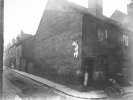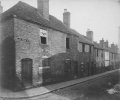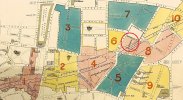-
Welcome to this forum . We are a worldwide group with a common interest in Birmingham and its history. While here, please follow a few simple rules. We ask that you respect other members, thank those who have helped you and please keep your contributions on-topic with the thread.
We do hope you enjoy your visit. BHF Admin Team
You are using an out of date browser. It may not display this or other websites correctly.
You should upgrade or use an alternative browser.
You should upgrade or use an alternative browser.
James Burgoyne photographic collection
- Thread starter Astoness
- Start date
James Burgoyne was a photographer located at 50 New Street and at128 Coventry Road c1875. He took many photographs of slum properties in Birmingham which were to be demolished as part of the 1870s Improvement Scheme.
This article by Alice Gavin (for the Canadian Centre for Architecture - CCA) explains some of his work:
“Initiated in response to the Artisans’ and Labourers’ Dwelling Improvement Act of 1875, the Birmingham Improvement Scheme saw the radical revision of an urban region spanning two central wards: veering slums were torn down (with dubious efforts at rehousing their inhabitants), and a sweeping “Parisian boulevard,” called Corporation Street, was constructed. In advance of these transformations, the Town Council–appointed Improvement Committee commissioned a series of photographs. Taken by James Burgoyne, whose photography studio was located on the Coventry Road, these photographs depict the oozing streets and skinny alleys no longer considered appropriate to an ambitious industrial town whose motto was “Forward.”
Collected in the archives of the CCA alongside comparable series, such as Thomas Annan’s photographs of Glasgow taken for the Glasgow City Improvement Trust in the 1860s, Burgoyne’s images do not simply document. They also actively participate in a process of obliteration. Constantly conscious of possibility, of prospects in all meanings of the word, their purpose was to record the town in order for the Improvement Committee to reassemble it. Accompanied by a map indicating their specific sites and locations and camera angles, the photographs were intended to be almost immediately obsolete, yet simultaneously to operate as a functional tool for spatial knowledge. In this sense, Burgoyne’s camera does not merely capture old Brummagem: it also exposes the possibility of a new Birmingham, pointing out where it will go, what it will oppose itself to.
In one photograph of a series of thirty-six, number twenty-nine on the map, the image is arranged to frame a squeezed passage known as the Gullet. On either side stand a pub, the Hope and Anchor, and a furniture depository. It is, though, the Gullet’s crooked gap that the composition emphasizes, to the extent that it seems as if the image itself is being snapped in two, cracked and fissured by its subject. The Gullet becomes not simply a good example of the narrow streets the Improvement Committee sought to eradicate; it is also presented as an urban feature with the capacity to fracture, dishevel, and disorganize of its own accord. Burgoyne’s pedestrian-eye-view, a position maintained throughout the series, is crucial in pointing this out.
In another photograph, number six on the map, we see a street entirely emptied of human inhabitants. But Little Cherry Street is not yet defunct. It is home to both J. Pullar and Sons and a W. H. Hart, provision broker, with both businesses occupying buildings whose brickwork is sturdy. Yet, this is again a photograph composed of two halves. On the left stand the sound structures of J. Pullar and Hart, while on the right, at once foregrounded and at the same time shrunken by its neighbours’ scale, is a structure slipshod and crumbling, its facade plastered with advertisements for “cheap excursions” to suburbs such as Sutton Coldfield. In other photographs, we see advertisements for migrations further afield and more irreversible: signs outside a shop tell of “assisted passages” to Canada with the promise of free grants of land and of boats leaving Liverpool for America every Thursday. In combination with notices representing buildings as “Lot 3” and “Lot 4,” these printed additions to the architecture announce a town that is, very literally, taking leave of itself. Burgoyne’s photographs do not only preserve and document; they also expose the streets they observe to what is to come“.
Viv.
This article by Alice Gavin (for the Canadian Centre for Architecture - CCA) explains some of his work:
“Initiated in response to the Artisans’ and Labourers’ Dwelling Improvement Act of 1875, the Birmingham Improvement Scheme saw the radical revision of an urban region spanning two central wards: veering slums were torn down (with dubious efforts at rehousing their inhabitants), and a sweeping “Parisian boulevard,” called Corporation Street, was constructed. In advance of these transformations, the Town Council–appointed Improvement Committee commissioned a series of photographs. Taken by James Burgoyne, whose photography studio was located on the Coventry Road, these photographs depict the oozing streets and skinny alleys no longer considered appropriate to an ambitious industrial town whose motto was “Forward.”
Collected in the archives of the CCA alongside comparable series, such as Thomas Annan’s photographs of Glasgow taken for the Glasgow City Improvement Trust in the 1860s, Burgoyne’s images do not simply document. They also actively participate in a process of obliteration. Constantly conscious of possibility, of prospects in all meanings of the word, their purpose was to record the town in order for the Improvement Committee to reassemble it. Accompanied by a map indicating their specific sites and locations and camera angles, the photographs were intended to be almost immediately obsolete, yet simultaneously to operate as a functional tool for spatial knowledge. In this sense, Burgoyne’s camera does not merely capture old Brummagem: it also exposes the possibility of a new Birmingham, pointing out where it will go, what it will oppose itself to.
In one photograph of a series of thirty-six, number twenty-nine on the map, the image is arranged to frame a squeezed passage known as the Gullet. On either side stand a pub, the Hope and Anchor, and a furniture depository. It is, though, the Gullet’s crooked gap that the composition emphasizes, to the extent that it seems as if the image itself is being snapped in two, cracked and fissured by its subject. The Gullet becomes not simply a good example of the narrow streets the Improvement Committee sought to eradicate; it is also presented as an urban feature with the capacity to fracture, dishevel, and disorganize of its own accord. Burgoyne’s pedestrian-eye-view, a position maintained throughout the series, is crucial in pointing this out.
In another photograph, number six on the map, we see a street entirely emptied of human inhabitants. But Little Cherry Street is not yet defunct. It is home to both J. Pullar and Sons and a W. H. Hart, provision broker, with both businesses occupying buildings whose brickwork is sturdy. Yet, this is again a photograph composed of two halves. On the left stand the sound structures of J. Pullar and Hart, while on the right, at once foregrounded and at the same time shrunken by its neighbours’ scale, is a structure slipshod and crumbling, its facade plastered with advertisements for “cheap excursions” to suburbs such as Sutton Coldfield. In other photographs, we see advertisements for migrations further afield and more irreversible: signs outside a shop tell of “assisted passages” to Canada with the promise of free grants of land and of boats leaving Liverpool for America every Thursday. In combination with notices representing buildings as “Lot 3” and “Lot 4,” these printed additions to the architecture announce a town that is, very literally, taking leave of itself. Burgoyne’s photographs do not only preserve and document; they also expose the streets they observe to what is to come“.
Viv.
Last edited:
I am moving this interesting thread with its collection of photos to our “Brum as it was” subsection (See “Made in Brum” section further down BHF home page).
Viv.
Viv.
Last edited:
Lyn, I've never seen James Burgoyne's photographs before, are they in the Library of Birmingham? The Gullet photograph could certainly tell a tale! The photographer would have used a plate camera with a tripod and a black cloth in 1880s. I wondered if the smartly dressed men at the back to the right could be police officers in plain clothes? Dickens when he wondered about the unsavoury parts of London often went with Inspector Field who was fictionalised in Bleak House as Inspector Bucket. Dickens also carried a 'life preserver' - a cosh in his pocket.View attachment 78618View attachment 78619View attachment 78620and now we have the imfamous pic of the gullet...i have posted this one before but it got lost in the hack..always found this most scary...this was situated at the site of the queen elizabeth law courts...
also court 7 back o 21 thomas st...
top left arrow...thomas st
bottom left arrow..the gullet..
A frightening photo indeed, thank you.
Derek
Last edited:
BrummieGeoff
Sparkhill Lad
Birmingham Library Archive Catalogue - online shows entries for some James Burgoyne photographs. As well as photographs of his premises.
https://calmview.birmingham.gov.uk/CalmView/Overview.aspx
https://calmview.birmingham.gov.uk/CalmView/Overview.aspx






